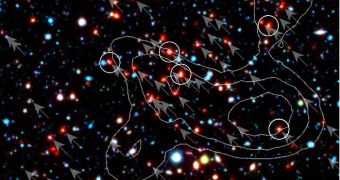Astronomers from Germany and Japan announce the discovery of the most distant galaxy cluster ever identified in the Universe. While single galaxies, stars and black holes have been found existing farther away than this, the experts underline the fact that this is the oldest, fully-formed galaxy cluster discovered. The formation resides some 9.6 billion light-years away from Earth, which means that it appeared some 4 billion years after the Big Bang exploded the Universe into being.
An additional element that supports the age estimate is the fact that the cluster mostly contains very old and very massive galaxies. Data on the amazing structure were collected in the infrared and X-ray wavelengths of the electromagnetic spectrum, as visible light cannot readily penetrate such large distances. The investigation could in itself help astronomers and astrophysicists gain new insight into how early galaxies developed, as well as into the order and structure of the Universe when the whole thing was still very young, Space Fellowship reports.
Most galaxies out there today exist in clusters, which are rightfully called the largest building blocks of the Universe. Even our own home, the Milky Way, is located inside such a structure, called the Virgo cluster. We are accompanied by an additional 1,000 to 2,000 “members,” all of which interact with each other via the force of gravity. Analyzing clusters therefore provides clues as to how galaxies within will evolve. Such studies also yield hints as to how the galaxies may have looked like before being sucked into the cluster.
The new investigation was conducted using X-ray observations from the XMM-Newton space observatory, and infrared readings from the Subaru Telescope's Multi-Object Infrared Camera and Spectrometer (MOIRCS) instrument. The candidate clusters were identified from the Subaru XMM Deep Field survey, and were then individually analyzed. “The MOIRCS instrument has an extremely powerful capability of measuring distances to galaxies. This is what made our challenging observation possible. Although we confirmed only several massive galaxies at that distance, there is convincing evidence that the cluster is a real, gravitationally bound cluster,” explains University of Tokyo astronomer Masayuki Tanaka.
“Despite the difficulties in collecting X-ray photons with a small effective telescope size similar to the size of a backyard telescope, we detected a clear signature of hot gas in the cluster,” adds researcher Alexis Finoguenov, who is based a the Max Planck Institute for Extraterrestrial Physics, in Germany. Scientists from the Kyoto University were also involved in the study.

 14 DAY TRIAL //
14 DAY TRIAL //